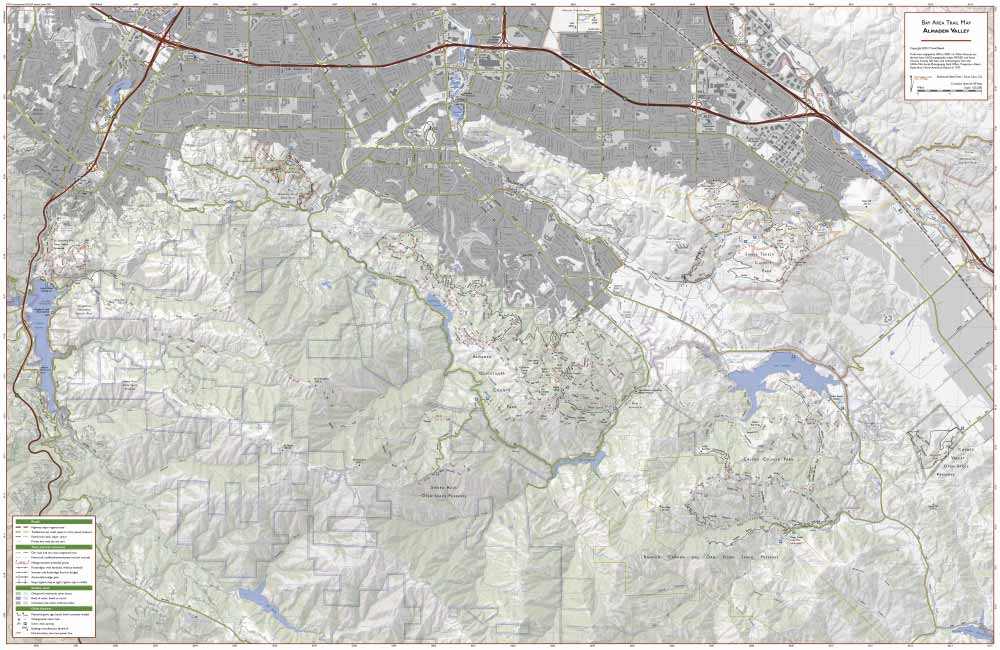

Some structures were built later by the U.S. The remains of a variety of structures left over from the 135 years of mining activity, including housing for the up to 1,800 miners, are scattered about the park, with the biggest concentration at what was known as English Camp, established by Cornish miners in the 1860s. By the time Santa Clara County bought the mines in 1976 and ended operations, 1,137,727 flasks totaling 83,974,076 pounds (38,090 metric tons) of mercury (worth more than US$70 million) had been extracted. It was declared a National Historic Landmark in 1961. After being identified as a Superfund site and after subsequent containment activities, the mining area can now be visited as part of the Santa Clara County Almaden Quicksilver County Park. The entrances to the mines are closed off.


The New Almaden Smelting Works in 1863 (photo by Carleton Watkins). There is a high probability of undiscovered high-grade ore which could be found and exploited using modern techniques. Mining, other than a single placer deposit of cinnabar, was underground. The only significant quicksilver ore is cinnabar other sulfides are present in small quantities. There are several smaller mines in the mining district, but their ore production was not significant. The Guadalupe mine produced about 10% as much mercury as the New Almaden. Quicksilver ore deposited by hydrothermal deposition of cinnabar from deep within the earth is found in a gangue of silica-carbonate rock formed locally by hydrothermal alteration of serpentine. The mineralized area in the Almaden mining district where the New Almaden and the nearby Guadalupe mine are located is within the large Franciscan Assemblage associated with the Coast Range. The California Department of Fish and Wildlife and the US Fish and Wildlife Service issued an environmental restoration plan for the area in 2008. In 2005 the responsible parties, which include private companies and local government agencies, agreed to a legal settlement of approximately US$6,750,822 for restoration projects. Mining operations resulted in mercury pollution of the Guadalupe River and South San Francisco Bay, impacting birds and aquatic species. Environment Ī specimen of Cinnabar (mercury ore) from the New Almaden Mines.

New Almaden also features prominently in her memoir A Victorian Gentlewoman in the Far West, which was later fictionalized by Wallace Stegner in his novel Angle of Repose. Her illustrated correspondence about New Almaden, "A California Mining Camp", appeared in the February 1878 issue of Scribner's Monthly. Representations of historical life at the New Almaden Mine were drawn in vivid detail by Mary Hallock Foote, the wife of Arthur DeWint Foote, the resident engineer from 1876. Īrthur De Wint Foote worked at New Almaden in the late 1870s under James Butterworth Randol. Mindful of the possibility of losing the loyalty of California during the Civil War, the federal government backed off and Barron, Forbes Company was allowed to sell it to American investors for $1.75 million. In 1863, acting on information that title to the mine had not been proven, Abraham Lincoln attempted to seize the mine, but the federal agent and deputy federal marshal were met at the mine gates by armed miners. Almadén and Idrija.) The term Almadén, meaning "the mine", is derived from the Arabic language. The mine is named for a mercury mine in (old) Almadén, Spain, which had operated since at least Roman times. One of the competing land claims was Rancho Los Capitancillos. On appeal to the Supreme Court of the United States the claim was found invalid in a decision rendered March 10, 1863. A claim of fraud was made on behalf of the Quicksilver Mining Company, which had acquired a competing land claim originating in an agricultural claim to the land the mine was on. Castillero's mining claim was confirmed by the Board of Commissioners that evaluated private land claims in California on January 8, 1856, but there was continued litigation in the District court, The United States vs. It was named "Nueva Almaden" by Alexander Forbes. Andres Castillero, a captain in the Mexican Army, obtained a grant to the mine in 1846 but, occupied with his military duties during the Mexican War, soon sold it to Barron, Forbes Company, an English textile firm based in Tepic, Mexico. The Carson Adobe, built from 1848 to 1850 by Mexican miners, is one of the oldest buildings in New Almaden.Ĭinnabar, bright red mercury ore, was used by the Ohlone people for paint, but the settlers soon saw its potential to produce quicksilver.


 0 kommentar(er)
0 kommentar(er)
